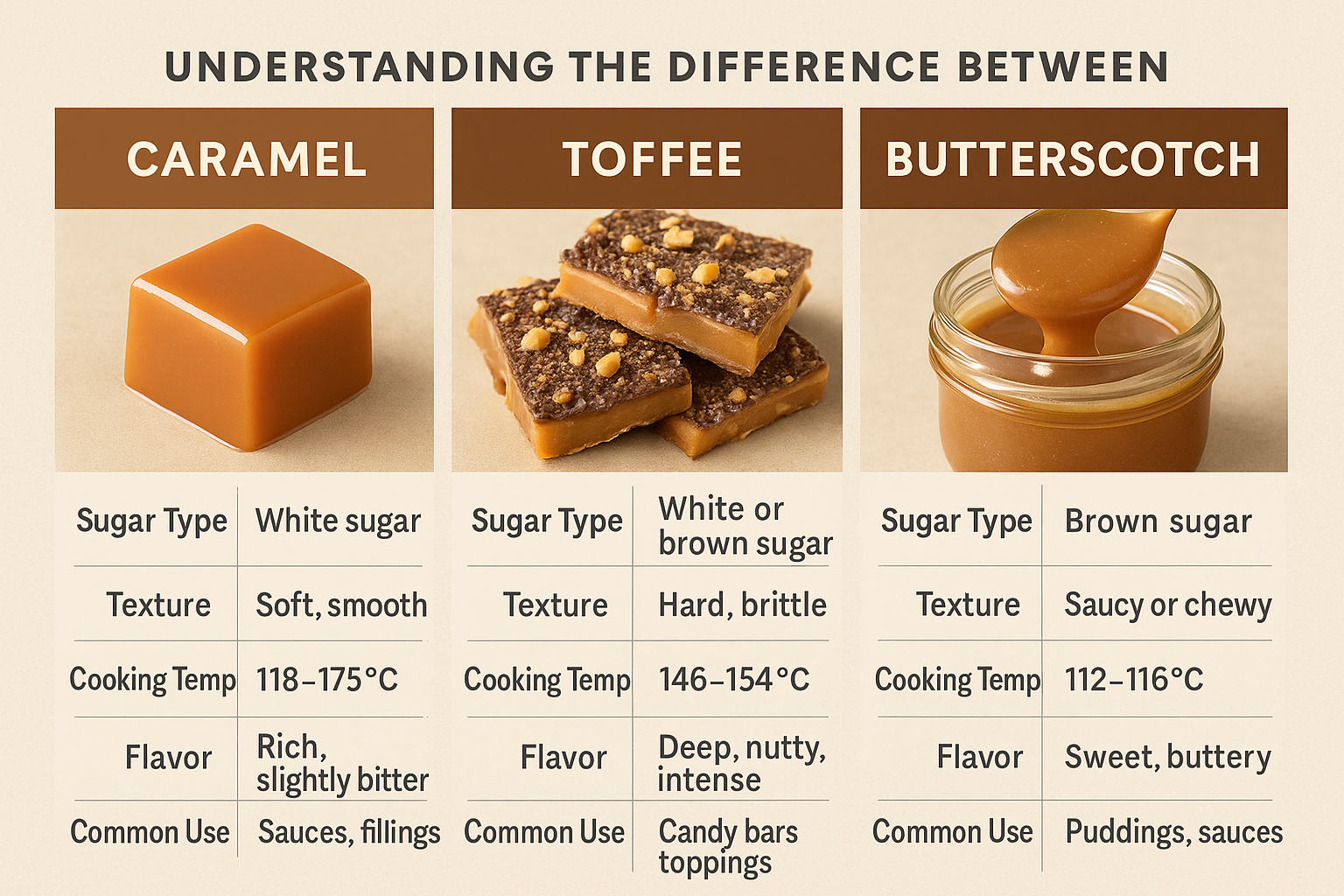Caramel, toffee, and butterscotch — they’re all golden, buttery, sweet, and rich. But while they might look and taste similar, each has its own distinct flavor, texture, and preparation method.
In this article, we’ll explore the key differences between these three delicious confections, how they’re made, and how to use them in your homemade desserts.
Why People Confuse Them
It’s easy to understand why caramel, toffee, and butterscotch get mixed up:
- All are sugar-based confections
- All have a buttery, golden-brown appearance
- All involve cooking sugar, often with butter or cream
- All are used in desserts, sauces, or candies
But the type of sugar used, cooking temperature, and texture are what truly set them apart.
1. Caramel
What Is It?
Caramel is made by heating sugar (usually white granulated sugar) until it melts and turns golden brown. It has a smooth, creamy texture and a deep, slightly bitter-sweet flavor.
Key Ingredients:
- White sugar
- Butter (optional)
- Heavy cream
- Vanilla or salt (optional)
Cooking Temperature:
- Caramel sauce: 170–175°C (338–347°F)
- Caramel candy: 118–120°C (244–248°F)
Texture:
- Can range from liquid sauce to soft chewy candy
- Stays smooth and melts in the mouth
Uses:
- Sauces for ice cream and cakes
- Chewy caramel candies
- Layer in desserts like flan or millionaire’s shortbread
- Caramel apples
✅ Caramel requires patience and careful heating to avoid burning.
2. Butterscotch
What Is It?
Butterscotch is similar to caramel but typically uses brown sugar instead of white sugar, giving it a deeper molasses-like flavor. It’s usually cooked with butter and cream, and it has a softer, more buttery taste.
Key Ingredients:
- Brown sugar
- Butter
- Cream
- Vanilla
- Salt (optional)
Cooking Temperature:
- Generally cooked to soft-ball stage: 112–116°C (234–240°F)
Texture:
- Often a soft, pourable sauce, but can also be made into candy
- Rich, smooth, and slightly grainy if overcooked
Uses:
- Butterscotch sauce for puddings and ice cream
- Flavored fillings in pies or cakes
- Base for butterscotch pudding or blondies
✅ Butterscotch is sweeter and less bitter than caramel.
3. Toffee
What Is It?
Toffee is a hard, crunchy candy made by cooking butter and sugar to a high temperature. It’s often poured into a slab, cooled, and broken into pieces.
Key Ingredients:
- White or brown sugar
- Butter
- Sometimes a touch of water or vanilla
Cooking Temperature:
- Hard-crack stage: 146–154°C (295–310°F)
Texture:
- Hard, brittle, and crunchy
- Can include nuts or be topped with chocolate
Uses:
- English toffee
- Candy bars and brittle
- Toppings for cakes or ice cream
- Crushed into baked goods or cookie dough
✅ Unlike caramel and butterscotch, toffee is meant to be firm and snappy.
Quick Comparison Chart
| Feature | Caramel | Butterscotch | Toffee |
|---|---|---|---|
| Sugar Type | White sugar | Brown sugar | White or brown sugar |
| Texture | Soft, smooth | Saucy or chewy | Hard, brittle |
| Cooking Temp | 118–175°C | 112–116°C | 146–154°C |
| Flavor | Rich, slightly bitter | Sweet, buttery | Deep, nutty, intense |
| Common Use | Sauces, fillings | Puddings, sauces | Candy bars, toppings |
Pro Tips for Working With Sugar
- Always watch the temperature — a candy thermometer is your best friend.
- Don’t stir too much once sugar begins boiling — it may crystallize.
- Use heavy-bottom pans to prevent burning.
- When making caramel or toffee, be ready to pour immediately once it reaches the right temp — it hardens fast!
- Add salt to balance sweetness and enhance flavor in all three.
Which One Should You Use?
- Want a drizzle for your dessert? Butterscotch or caramel sauce.
- Craving something chewy? Try caramel candy.
- Need a crunchy texture? Go for toffee.
- Prefer warm and sweet? Butterscotch wins.
Each has a place in the dessert world — and now that you know the difference, you’ll never confuse them again.

